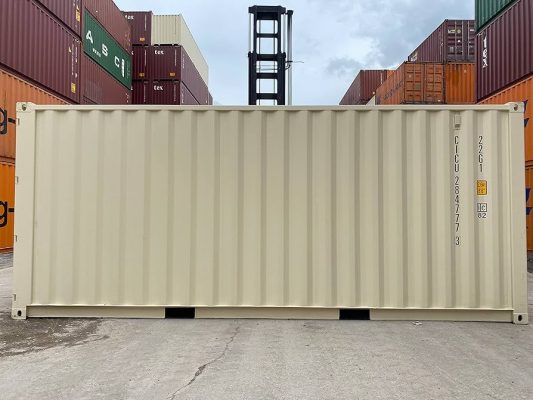The Pros and Cons of Using Shipping Containers for Construction Projects

Shipping containers have become an increasingly popular choice for a variety of construction projects, ranging from residential homes to offices, shops, and even schools. Their versatility, affordability, and eco-friendly nature make them an appealing option, but like any construction material, they come with both benefits and drawbacks. This blog explores the pros and cons of using shipping containers in construction to help you decide whether this innovative approach is right for your next project.
Pros of Using Shipping Containers for Construction
1. Cost-Effective
One of the most compelling reasons to use shipping containers in construction is their cost-effectiveness. Traditional building materials like wood, brick, and steel are often more expensive. Shipping containers, especially second-hand ones, are readily available and can be purchased at a fraction of the cost of traditional materials. Additionally, since shipping containers come pre-built, the cost of labor for constructing the basic structure is significantly lower, making them an attractive option for budget-conscious builders.
2. Durability and Strength
Shipping containers are designed to withstand extreme weather conditions, heavy loads, and rough handling, making them incredibly durable. Constructed from corten steel, which is highly resistant to corrosion, these containers can last for decades if properly maintained. This durability makes them ideal for projects in areas prone to harsh weather or where a strong, long-lasting structure is required.
3. Eco-Friendly Option
Using shipping containers for construction can be an environmentally friendly choice. Repurposing used containers reduces the demand for new building materials, helping to conserve natural resources and reduce the carbon footprint associated with manufacturing new materials. Additionally, by reusing shipping containers, you prevent them from being discarded as waste, which helps to reduce landfill use.
4. Quick to Build
Traditional construction projects can take months or even years to complete, especially for large or complex builds. Shipping containers, on the other hand, offer a faster alternative. Since the containers come pre-built, the process of converting them into usable structures is relatively quick. Once the design and customization are finalized, a container home or office can be completed in a matter of weeks, allowing you to move in much sooner than with a conventional build.
5. Modular and Customizable
Shipping containers are inherently modular, which means they can easily be stacked, arranged, or combined to create larger structures. This modularity allows for creative design possibilities, whether you’re building a small home or a multi-story office complex. Additionally, shipping containers can be customized with windows, doors, insulation, plumbing, and electrical systems to meet specific project needs.
Cons of Using Shipping Containers for Construction
1. Size Limitations
One of the major limitations of using shipping containers in construction is their size. Standard containers come in two sizes: 20 feet and 40 feet in length, with a width of 8 feet and a height of 8.5 feet or 9.5 feet (high cube). While these dimensions can work well for some projects, they can feel restrictive for others. The narrow width, in particular, can pose design challenges, especially for those looking to create open, spacious interiors.
2. Insulation and Temperature Control
Shipping containers are made of steel, which conducts heat and cold very effectively. This means that without proper insulation, they can become extremely hot in the summer and very cold in the winter. Installing insulation and temperature control systems, such as heating, ventilation, and air conditioning (HVAC), can add to the cost and complexity of the project. Without proper planning, maintaining a comfortable indoor environment can be difficult.
3. Structural Modifications Can Be Challenging
While shipping containers are strong and durable, making structural modifications—such as cutting out windows, doors, or large openings—can compromise their integrity. These modifications require specialized skills and equipment, adding to the overall cost and complexity of the build. It’s important to work with experienced professionals who understand how to safely modify the containers without weakening the structure.
4. Zoning and Building Codes
Shipping container construction is still a relatively new concept in many areas, and as a result, zoning regulations and building codes may not always accommodate them. Before starting a project, it’s crucial to check local laws and obtain the necessary permits. In some areas, container homes or offices may be restricted or require special approvals, which can delay the project and add to the overall cost.
5. Health and Safety Concerns
Used shipping containers may have been exposed to chemicals, pesticides, or other hazardous substances during their previous use. Before repurposing a container for construction, it’s essential to inspect it for any potential health risks and ensure that it’s properly cleaned and treated. This can add an additional layer of cost and complexity to the project.
Conclusion
Shipping containers offer a unique and innovative solution for construction projects, providing cost savings, durability, and eco-friendly benefits. Their modularity and quick build times make them particularly appealing for those looking for a flexible and efficient construction option. However, it’s important to be aware of the potential challenges, including size limitations, insulation requirements, structural modifications, and zoning issues.
 Singapore
Singapore Australia
Australia Indonesia
Indonesia Japan
Japan Malaysia
Malaysia New Zealand
New Zealand Philippines
Philippines South Korea
South Korea Taiwan
Taiwan Thailand
Thailand VIETNAM
VIETNAM
